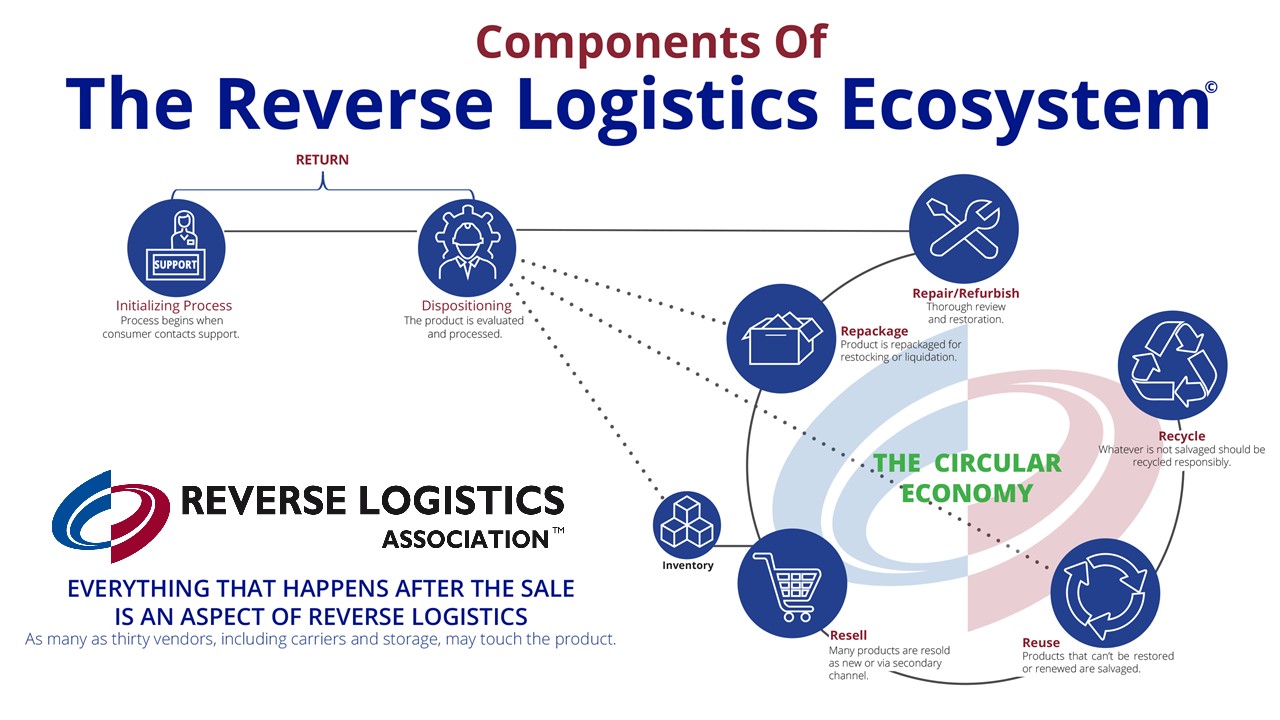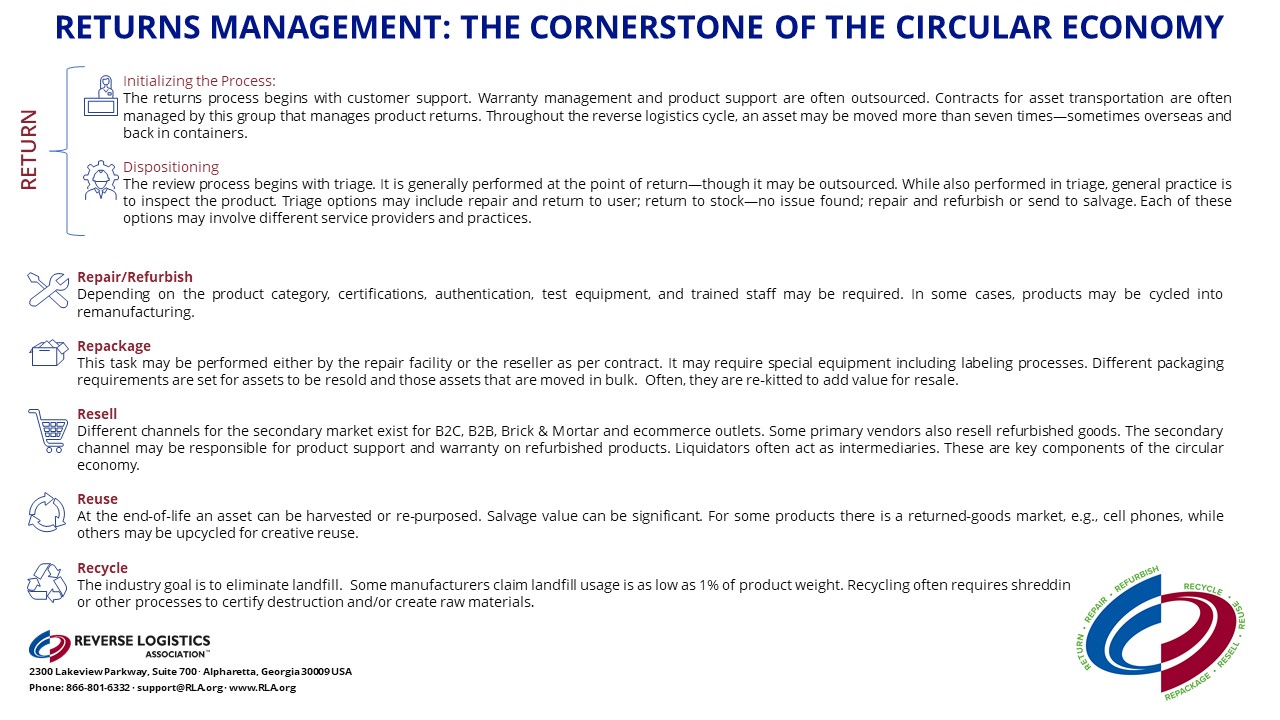What Is The Reverse Logistics Ecosystem?
By Dr. Ron Lembke, University of Nevada
This is a question with many answers, and one the Reverse Logistics Association has been engaged with since its inception. As technology has changed the products and services on offer in the world, the reverse logistics needs have also changed. The RLA has recently published a diagram of the Reverse Logistics Ecosystem.
Most Third-Party Service Providers (3PSPs) operate in multiple, if not many, of these categories.
We are separating the ecosystem into five basic categories:
- Returns
- Repair
- Resell
- Recycle
- Resources
RETURNS
The Reverse Logistics process really begins the moment the decision is made that a product is not suitable at the current location.
For the majority of products, this happens when the customer returns the item to the retail location. The customer may have interacted with various customer service and support resources and personnel. Well-designed instructions, manuals, and videos can be the key to helping people successfully enjoy their product, and prevent returns.
Customers want to know if their item is under warranty, and need information about where to send the item and how to get parts or a replacement. Vendors often provide labeling and/or packaging for the reverse shipment, and in some cases, pick up the item.
In some cases, like shelf pulls, the reverse logistics journey begins when items are taken off the retail shelf. For other products, the diversion happens before the units even leave the distribution center. In either case, the product may travel through the company’s internal logistics network.
REPAIR, REFURBISH, REPACKAGE
Once the item has entered the RL system, the next key step is triage, where the unit’s next destination is chosen. What will happen to the item? Should it be repaired? Sold off as is? Recycled?
To make this determination, some type of initial assessment of the condition of the item must be made about which disposition option to send the item to, so it must be triaged. In order of decreasing net value, an item may:
- be sold as new,
- be sold as a new, open-box item,
- with repackaging, be sold as new,
- with refurbishing, be sold as renewed or refurbished,
- be sold to a broker for secondary market sales.
- have valuable components and materials salvaged from the item, so it can be recycled.
The results of this assessment will determine its next destination.
In order to be sold, many items need to be repaired, refurbished and/or repackaged, all of which we include under this category because the processes are so closely related, depending on how a firm defines the terms.
Repair may refer to the least intensive action being performed on the unit itself. In some cases, refurbishing may refer to a largely cosmetic task of replacing the plastic front, back, or sides of a device. In other cases, and other types of products, it may refer to repairing and replacing multiple functional components as well as cosmetic ones.
Once the item has been brought into compliance with the target level of functional and cosmetic performance, the item needs to be packed for shipping and sale. These requirements will be quite different, depending on the sales channel it will be sold through. For bulk shipments, a simple wrapping with protective material may suffice. But for online sales, the item needs to be packaged to ensure safe arrival to the customer. For retail sales, the packaging may have to match or be similar to, the original manufacturer’s packaging.
RESELL
To realize the revenues for an item, it must be resold. Many firms will opt to not become involved with the processes of repair, refurbishing, and repackaging, and simply sell the items off, in bulk, to brokers.
The buying and selling of products after the original sale by the producer is called the secondary market.
Before an electronic item can be disposed of, all data on the device must be properly safeguarded, and this is a key value-added feature of ITAD (Information Technology Asset Disposition) firms. Companies have to be able to prove, to the client’s satisfaction, that all data has been properly protected, to the client’s standards, throughout the process.
The brokers who buy these items may specialize in only surplus goods, that is new goods from shelf pulls or DC pulls. Others specialize in salvage goods, either returned or damaged goods. Many brokers deal in both.
Regardless of whether an item has been reconditioned and repackaged, or is being sold as-is, there are many possible channels that the firm may sell their units to, generally rising in revenue per unit:
- sold in bulk,
- individually sold as wholesale,
- sold direct to the consumer online, or
- sold in a retail store.
Many brokers will buy in bulk from retailers or manufacturers, and sell smaller lots to smaller firms.
RECYCLE
Once the product has definitely reached the end of its economic life as a stand-alone product, as much economic value as possible must be extracted from the device while contributing the least possible environmental damage.
Once the device has been sanitized, the product can be disassembled, and parts of value can be removed. Knowing how to gain the maximum net revenue from the disassembly of the item is an important service 3PSPs provide.
Proof of environmental compliance, from a company certified by R2 or e-Stewards, is necessary for many firms.
What remains after all of the components of value have been extracted can hopefully be recycled, but what cannot be recycled must be landfilled, in accordance with relevant regulations.
RESOURCES
Some 3PSPs provide services for all of the functions above. But all of those categories of RL activities are made possible by other service providers. Without third-party logistics providers (3PLs), most companies would have no way to move the products, nor any place to store them. Many 3PSPs also provide these services or work with 3PLs to provide them with a seamless experience for their clients.
Many companies benefit from consulting services provided by consulting firms, or by 3PSPs.
Software for tracking and managing all of the RL flow is a critical necessity, and may also be provided by 3PSPs.
Other vital resources include things such as material handling equipment, bar code scanners, and packaging and repackaging materials.
Visit the RLA website at rla.org/site/about for more information.


 Dr. Ron Lembke
Dr. Ron LembkeRon Lembke is an Associate Professor of Supply Chain Management at the University of Nevada, and Director of the Summer Logistics Internship Program. He received his Ph.D. and MS degrees in Industrial Engineering from Northwestern University, and his undergraduate degree in mathematics with a computer science concentration from St. Olaf College in Northfield, Minnesota.
Ron is co-author, with Dr. Dale Rogers, of 'Reverse Logistics for Competitive Advantage,' a forthcoming CSCMP Explores publication, and 'Going Backwards: Reverse Logistics Trends and Practices,' published by the Reverse Logistics Executive Council.
His reverse logistics consulting experience includes projects with a number of large American companies, and he has been an invited speaker on Reverse Logistics in Brazil, Canada, Colombia, England, France, Mexico, and Spain. In the Fall of 2005, Ron was on sabbatical as a visiting professor at the corporate offices of 3M in St. Paul, Minnesota.
His research has appeared in journals such as the Journal of Business Logistics, The California Management Review, and The International Journal of Physical Distribution and Logistics Management. He is a two-term Past President of the Logistics Section of INFORMS, the Institute for Operations Research and the Management Sciences.